When a beginning microscopist looks through a microscope at an organism, the first question asked is "what is the name of that thing?" It is in the nature of man to want to organize, classify and name anything that we study and a complicated system has been developed to try to match the extraordinary complexity of nature. We want to know how living things are related to each other and to things that once lived but are now extinct. However, any system we devise is manmade and will always in some sense be arbitrary. No matter how many levels of classification we have or how many divisions within each level are assigned, there will always be those who argue for different or fewer or greater divisions.
The current system owes it genesis to the father of modern classification or "taxonomy", a Swede named Carl von Linné (1707-1778). He is better known by the Latinized name he adopted, Carolus Linnaeus. Linnaeus introduced the hierarchy from broadest to most specific which today with some amendment consists of a "kingdom", "phylum" or "division", "class", "order", "family", "genus", and "species".
From Aristotle's time until at least the mid-twentieth century, there were two kingdoms of life recognized—Plants and Animals (or Plantae and Animalia in Latin). However, starting in the late nineteenth century, this number began to be questioned with regard to the simpler life forms which were often not easily classified into one of the two kingdoms. A current approach now argued for is for five kingdoms—Prokarya or Bacteria, Animalia, Plantae, Fungi and Protoctista.
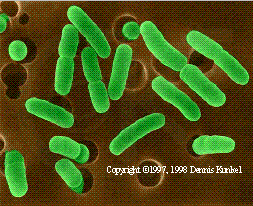 The Kingdom Prokarya or
Bacteria are distinguished from the life forms in all other
kingdoms in that they do not have a membrane bound nucleus
containing the genetic material of the cell. They are called
"prokaryotes". The genetic material is simply found
in strands ("plasmids") within the cell's
cytoplasm. Note that what was previously called blue green
algae are now classified as cyanobacteria because they are
prokaryotes. Since they are so different from all other life,
under the five kingdom system, Bacteria also comprise the
Superkingdom Prokarya.
The Kingdom Prokarya or
Bacteria are distinguished from the life forms in all other
kingdoms in that they do not have a membrane bound nucleus
containing the genetic material of the cell. They are called
"prokaryotes". The genetic material is simply found
in strands ("plasmids") within the cell's
cytoplasm. Note that what was previously called blue green
algae are now classified as cyanobacteria because they are
prokaryotes. Since they are so different from all other life,
under the five kingdom system, Bacteria also comprise the
Superkingdom Prokarya.
The cells of life forms in
the other four kingdoms are classified as
"eukaryotes" and have a nucleus in which the
genetic material is organized on "chromosomes"
within a cellular nucleus. These four kingdoms comprise the
Superkingdom Eukarya. Besides the presence or
absence of a nucleus, there are other major differences
between prokaryotes and eukaryotes. For example, Bacteria are
all over the map in whether they utilize oxygen or another
gas such as nitrogen or methane. Some cannot even tolerate
oxygen—for these "anaerobic"
Bacteria, oxygen is a poison. Almost all eukaryotes are
aerobes—they need oxygen to live. That some
Bacteria require an oxygen-free environment harkens back to
the earth's earliest times and suggest their ancient origin.
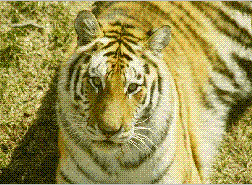 The Kingdom Animalia is
comprised of multi-celled organisms which develop from an
embryo resulting from the fertilization of an egg by a much
smaller sperm. However, even among the vertebrate animals,
there is an exception to sexual reproduction that makes the
definition slightly less than a 100% accurate. A species of
lizard of the genus Cnemidophorus reproduces by
parthenogenesis—no males or sperm required. Yet I
think everyone would accept that this lizard is an animal
(this lizard being one exception that proves the rule—there are other a few other
parthenogenetic animals). Animals also share the
characteristic that most must ingest or eat other living or
decayed organic matter as food to live (or live as parasites
or symbionts off of the nutrients provided by other living
things) (although this trait is also shared with some of the
members of the Kingdom Protoctista).
The Kingdom Animalia is
comprised of multi-celled organisms which develop from an
embryo resulting from the fertilization of an egg by a much
smaller sperm. However, even among the vertebrate animals,
there is an exception to sexual reproduction that makes the
definition slightly less than a 100% accurate. A species of
lizard of the genus Cnemidophorus reproduces by
parthenogenesis—no males or sperm required. Yet I
think everyone would accept that this lizard is an animal
(this lizard being one exception that proves the rule—there are other a few other
parthenogenetic animals). Animals also share the
characteristic that most must ingest or eat other living or
decayed organic matter as food to live (or live as parasites
or symbionts off of the nutrients provided by other living
things) (although this trait is also shared with some of the
members of the Kingdom Protoctista).
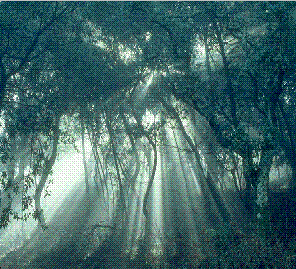 The Kingdom Plantae
is composed of multi-celled organisms that grow from embryos
that are usually the result of sexual fusion of a male and
female cell. Again there are exceptions although somewhere in
every plant's past, there were sexual forbears. Most plants
(but again not all) plants engage in photosynthesis—that complicated and almost
miraculous process whereby the energy of sunlight is used by
the plant to produce carbohydrates and gaseous O2from
H2O and CO2. As a result, plants are
the great producers of life. Plants generally have a rigid
cell wall composed of cellulose. They are non-motile (the
entire organism does not move about under its own energy) but
some produce motile cells.
The Kingdom Plantae
is composed of multi-celled organisms that grow from embryos
that are usually the result of sexual fusion of a male and
female cell. Again there are exceptions although somewhere in
every plant's past, there were sexual forbears. Most plants
(but again not all) plants engage in photosynthesis—that complicated and almost
miraculous process whereby the energy of sunlight is used by
the plant to produce carbohydrates and gaseous O2from
H2O and CO2. As a result, plants are
the great producers of life. Plants generally have a rigid
cell wall composed of cellulose. They are non-motile (the
entire organism does not move about under its own energy) but
some produce motile cells.
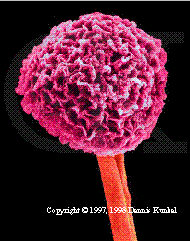
The Kingdom Fungi is comprised of non-motile cells
that have cell walls made of chitin (the same hard stuff that
the outer bodies of insects are made of) and not cellulose.
Therefore, some argue that fungi are more closely related to
animals than plants. Fungi develop from spores without any
embryonic stage. They digest other living things outside
their bodies by releasing enzymes and then absorbing the
product.
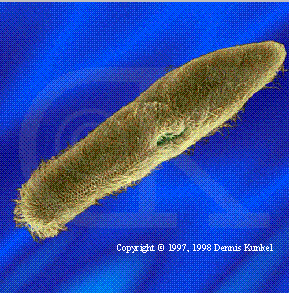 Kingdom Protoctista is the
catch-all kingdom for everything that does not fit into the
other four. It is comprised of many microscope organisms that
are of great interest to this group (as well as some
macroscopic organisms). These include protozoa (or protista
under the more modern name) and algae but also such diverse
organisms as slime molds and slime nets. Although we often
think of this group from its microscopic members, it is also
comprised of some large organisms such as giant kelps that
can grow as much as 10 meters (over 30 feet).
Kingdom Protoctista is the
catch-all kingdom for everything that does not fit into the
other four. It is comprised of many microscope organisms that
are of great interest to this group (as well as some
macroscopic organisms). These include protozoa (or protista
under the more modern name) and algae but also such diverse
organisms as slime molds and slime nets. Although we often
think of this group from its microscopic members, it is also
comprised of some large organisms such as giant kelps that
can grow as much as 10 meters (over 30 feet).
The five kingdom model is not universally accepted. Some argue for three (with the bacteria divided among two and all eukaryotes in one), two (prokaryotes in one and eukaryotes in the other) or even one. Some go in the other direction and argue that the inhabitants of the Kingdom Protoctista are simply too diverse for one kingdom and should be divided into separate kingdoms.
Any of the divisions and assignments below the kingdom level are also the subject of constant debate and change. The most specific level of the classification system is the species. Linnaeus devised a naming system for species that is still in use today. The genus is named first and is capitalized followed by the species which is not. Both the genus and species are often italicized. When organisms are referred to in Micscape articles, it is often by their genus. For example, Amoeba and Paramecium are each an example of a genus. Examples of species under each of these genera (plural for genus) are Amoeba proteus and Paramecium caudatum respectively.
How do you decide how to classify organisms into each of the narrowing categories? The classic method used was through visual (and later microscopic) identification of the form of the organism. At the higher or more general levels of classification, such distinctions are easier to make (but not always easy). They become increasingly more difficult as you become more specific. For example, how do you decide an individual organism is a member of one species and not another? The classic definition of a "species" is related organisms that share common characteristics and are capable of interbreeding. This works fine for "higher" (from our homocentric viewpoint) life forms such as Homo sapiens, the species to which you and I belong (or at least I do). We look significantly different than chimpanzees and cannot mate with them to produce offspring despite being closely related.
The problem is that this definition breaks down or is more difficult to implement in the "lower" life forms which microscopists are particularly interested in, depending on what one means by "interbreeding". For example, all different types of bacteria, although they do not reproduce sexually, are notoriously "promiscuous" about exchanging genetic material between species (such as how to become resistant to antibiotics). Further, different species (and even genera) of microorganisms look confusingly similar.
More modern tools have come into play. One way is to not only go by appearance but the life cycles, habitat, and chemical processes of organisms. For example, we would have little to go on if we only used the form of bacteria. They come in a relatively few forms. In 1884, Hans Christian Gram developed the staining technique which bears his name and is an early example of using a chemical means of differentiating bacteria. Gram noticed that some bacteria stained purple (called gram positive) and some pink (gram negative) using his method. This differentiation has proven to be much more than a merely interesting artifact of Gram's staining process but an indicator of fundamental micro-structural differences between gram positive and negative bacteria. Electron microscopy has confirmed that gram negative bacteria have a double cell wall which gram positive bacteria do not. Biochemical research has also determined that there is a significant difference in the molecules which make up the cell wall. How the bacteria reacts to its environment and to drugs can be significantly affected by these variances. Further, there are still some unanswered questions about the biological differences between gram positive and negative bacteria.
Perhaps the most modern and significant means of differentiating organisms and finding interrelationships today is through the incredible increase in our knowledge of genetics. It is now possible to sequence and compare the genes in different organisms and this has led to wholesale reclassifications in the last couple of decades of organisms which are now found to be unrelated even though similar in appearance. It has also lead to striking conclusions advanced by many that the more complex cells of higher organisms with membrane bound organelles are the ancestors of simple bacteria developing symbiotic relationships with each other and some eventually giving up their individual identity over time. Perhaps the most interesting example is the close genetic relationship between chloroplasts in plants and cyanobacteria which are capable of a form of photosynthesis. The genetic material in the chloroplasts shows a close affinity with that of cyanobacteria but not with that in the plant cell's nucleus. It seems likely, therefore that one of the most important aspects of plants, their ability to conduct photosynthesis was derived by importing and later adopting cyanobacteria.
The one trouble with these modern methods of classification is that they are generally not available to help in classifying extinct species.
Whenever, new knowledge is developed, there will always be realignments in the classification system and disputes will arise. When looking at protoctista, it sometimes takes an expert to identify what you are looking at (and they can be wrong too). It is also very possible that you are seeing a species or even genus that has never been identified before (I have seen estimates that for every known species of protoctista, there may be 6 to 25 unidentified species—who knows). Therefore, when you read the name of an organism, or someone identifies it for you (or even if you identify it yourself), take the name given with a grain of salt.
Acknowledgments
Large parts of this article were based on the books of Prof. Lynn Margulis and particularly the Five Kingdoms: An Illustrated Guide to the Phyla of Life on Earth, 3rd Edition, Lynn Margulis, Karlene V. Schwartz / Hardcover / Pub. Price: $39.95, published January 1998 by W. H. Freeman & Co. More information about this book and the methodology reflected in it can be found at the publisher's Web site. To go there, click on W. H. Freeman. (Editor's note: also see Micscape Book Review May 1998).
I would like to thank Dr. Dennis Kunkel for permission to use three of his
breathtaking images. Please click on his name to go to his
Web page and see more of his outstanding photography through
the microscope. I would also like to thank Bill Amos, Dave
Walker and my wife, Sally-Jo for taking the time to read a
draft of this article and providing me with some helpful
comments.
Copyright 1998 David Goldstein Please click on my name to send me an e-mail. I would appreciate any comments or thoughts you have.
Microscopy UK Front Page
Micscape Magazine
Article Library
© Microscopy UK or their contributors.
Please report
any Web problems or offer general comments to the Micscape Editor,
via the contact on current Micscape Index.
Micscape is
the on-line monthly magazine of the Microscopy UK web
site at Microscopy-UK